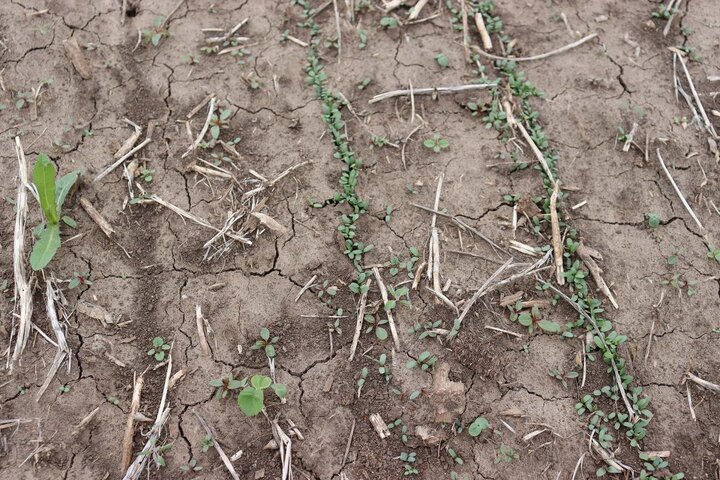Pests Causing Problems for Alfalfa
Insects are causing problems for alfalfa across Nebraska. Stay tuned as I describe what to look for in your fields and what to do if an issue does arise.
From alfalfa weevil larvae and adults to potato leafhoppers, to army worms, cutworms, alfalfa caterpillars to all kinds of aphids, somebody, somewhere has had enough of each of these insects feeding on their alfalfa, damaging new seedlings or regrowth. If you have been lucky enough to avoid these pests thus far, don’t assume you are safe for the remainder of the year.
Be sure to get out and scout your fields. I’d love to be able to generalize and tell you exactly how many insects per square foot or sweep of a net is needed to economically justify a control treatment for alfalfa. But each insect and disease are different. It can range from one spotted alfalfa aphid per seedling to 100 pea aphids on 20-inch alfalfa, or from one or two armyworms per square foot in new stands to at least 10 alfalfa caterpillars per sweep in established stands. Not all diseases cause issues.
What we use for control also varies. Simply cutting often works for many soft-bodied insects. Control using natural organisms like the Bt in Dipel and Thuricide will work for some insects. And of course, insecticides. But what insecticide or fungicide to use will be different depending on the insect.
So, my take home message today is scout and identify what is plaguing your field. Look for slow regrowth or weak seedlings and scout for insects or diseases that might be causing the issue. Be sure to dig in the soil and dead litter to find insects hiding during the day. Then identify exactly what you are dealing with. If you need help, stop in at your county extension office. Remember, many insects you find will be beneficial and some diseases don’t cause yield issues.
And finally, use appropriate treatments to protect your alfalfa.
Irrigating Alfalfa In-season
Alfalfa is a relatively drought-tolerant forage, but irrigation makes it possible to produce higher yields. This perennial crop does not have specific critical growth stages when it is less sensitive to water stress. If water is not available, the plant will slow or stop growing and go dormant. Then, when water becomes available, growth resumes.
Alfalfa has a longer growing season, and it uses more water annually compared to other crops. However, you can over-water alfalfa, resulting in plant injury and possibly weed invasion. Maintaining water use efficiency can be complicated due to multiple harvests preventing irrigation for about seven to 10 days per growth cycle and frequent heavy equipment traffic compacting soils. To reduce compaction, stop irrigating two to three days before cutting the alfalfa and irrigating again when alfalfa regrowth begins. Heavy irrigation of alfalfa stubble may encourage weed growth.
Irrigation scheduling efficiency can be improved with using ET gages and/or soil moisture monitoring technology. Accurate weather forecasts can also allow growers to take full advantage of rainfall events and reduce irrigation applications.
Now that our summer temperatures and growth rates are increasing, daily water use is also increasing. Generally, the most yield impacting irrigation occurs just before the second cutting followed by the third and fourth growth periods typically requiring 6-7 inches of irrigation. Peak water usage is about 1/3 inch per day in July and August. However, hot, windy and dry days can move the maximum water demand up to ½ inch per day, so ET scheduling can provide economic benefits.
For more details about alfalfa irrigation, visit the UNL Water website. Our NebGuide, G1778, “Irrigation Management and Crop Characteristics of Alfalfa” is a free useful resource.
Managing Seeding Year Alfalfa

Alfalfa seeded this spring is ready, or soon will be ready to cut. Hot, dry weather means proper care and management now could have big impacts on cuttings later this year. Use the following harvest guidelines to get the most from your first-year alfalfa.
Seeding year alfalfa is different from established stands. Stems are spindly, roots are small and shorter, and growth is a little slower.
You can harvest seeding year alfalfa as early as 40 days after seedlings emerge. Again, this is 40 days after emergence, not planting. Alfalfa takes about 40 days to develop the ability to regrow from the crown after cutting. Plants cut before this point need at least one set of leaves remaining to regrow. So, if you need to cut early for something like weed or insect control, cut high.
Although alfalfa seedlings can be harvested 40 days after emerging, I think it’s better to wait until around 60 days after emergence — at late bud to early bloom stage — before the first cutting. Yield will be a little higher and plants will withstand weather stress easier with a little extra growth. This extra time also allows increases root development, helping avoid problems from soil compaction or surface soil dryness.
After the first cutting, regrowth of seedling alfalfa will become more similar to established alfalfa, giving you the opportunity for two or three cuts the first year.
One last point — while it may seem like a long way off, never cut seeding year alfalfa during the four week period before a killing freeze. Winter injury can be severe due to reduced winterhardiness of new plants. Look ahead at the calendar now to plan when future cuts might be taken to avoid cutting during this sensitive time.
First year alfalfa can be productive, just manage it right.
